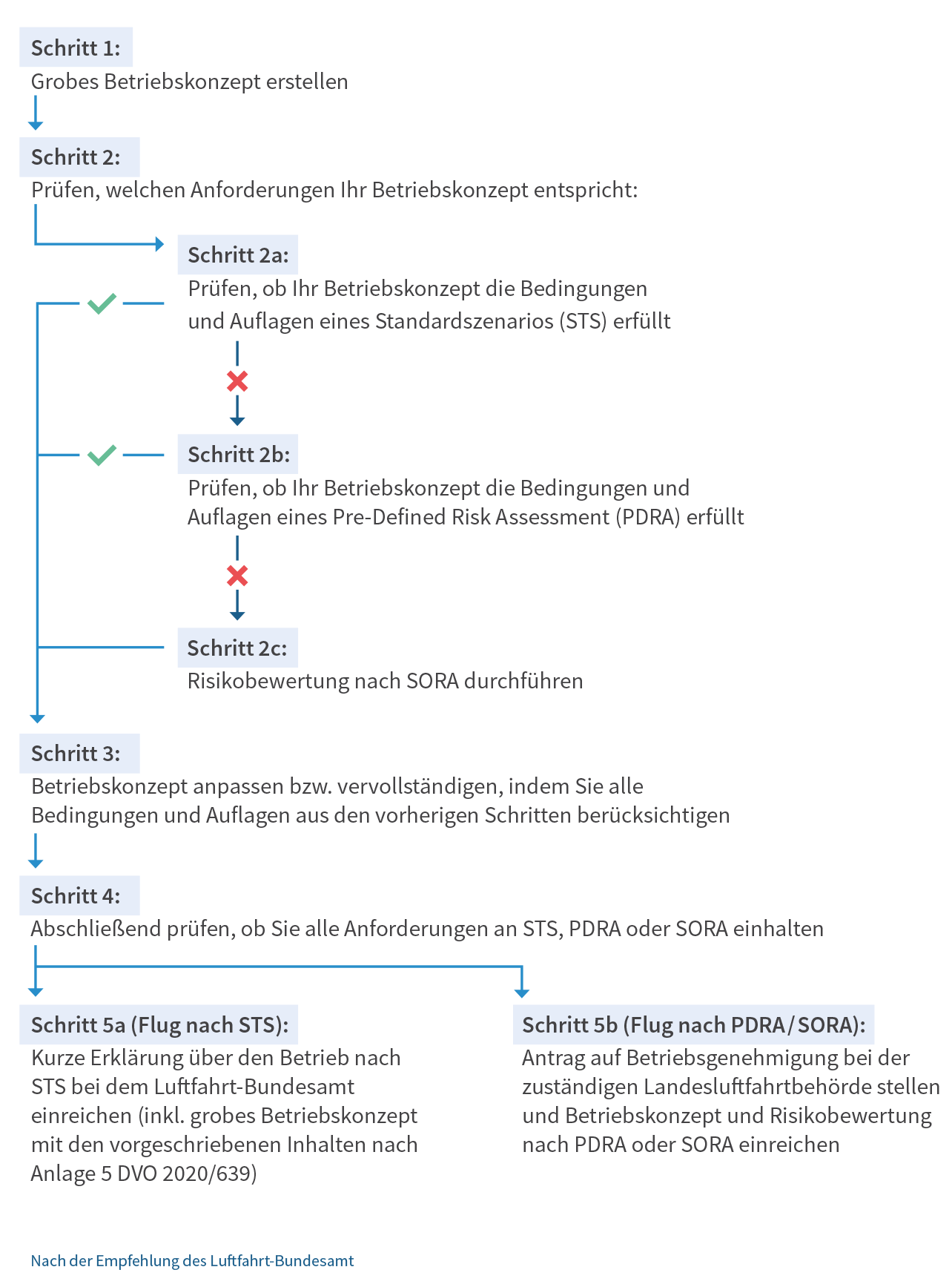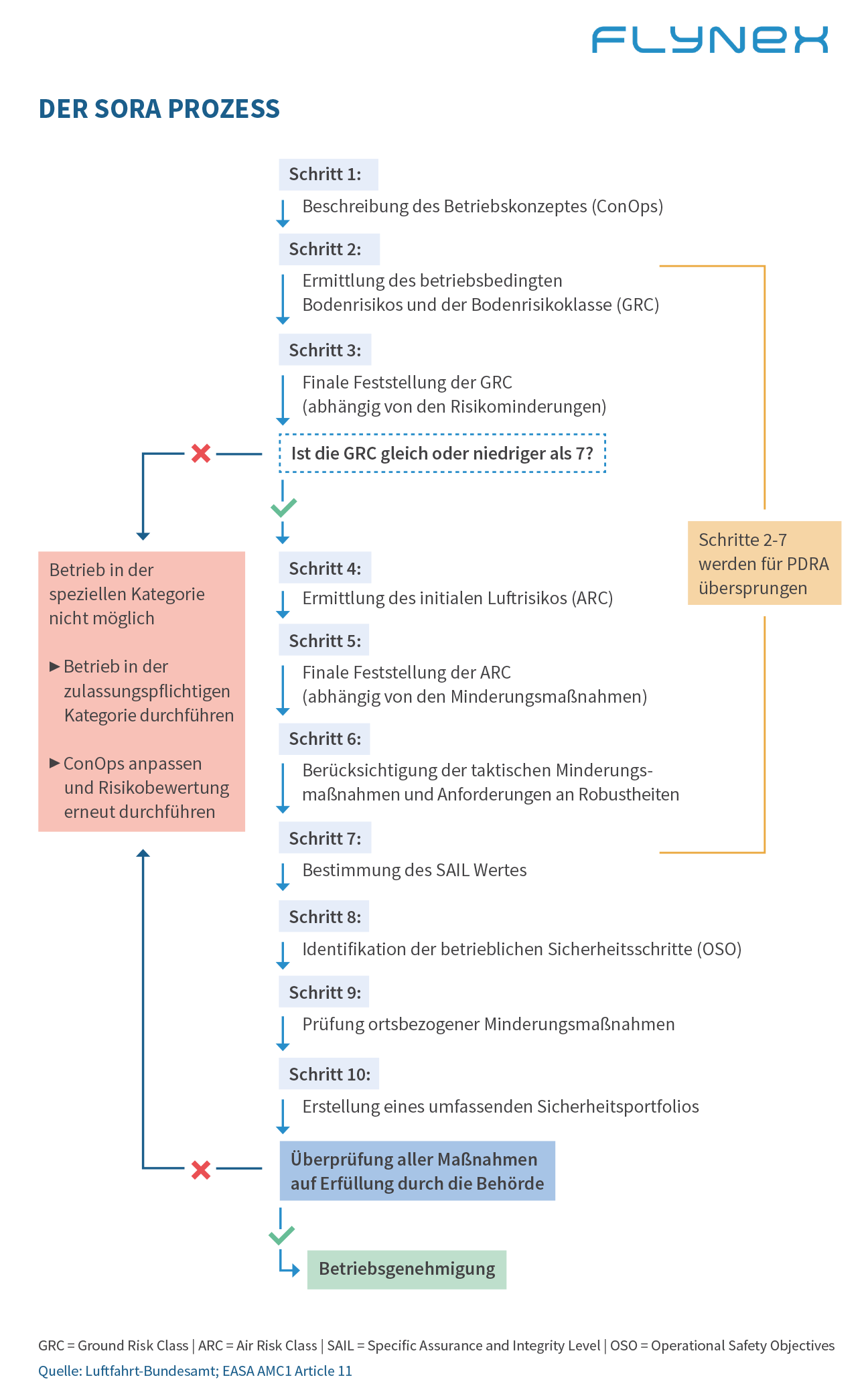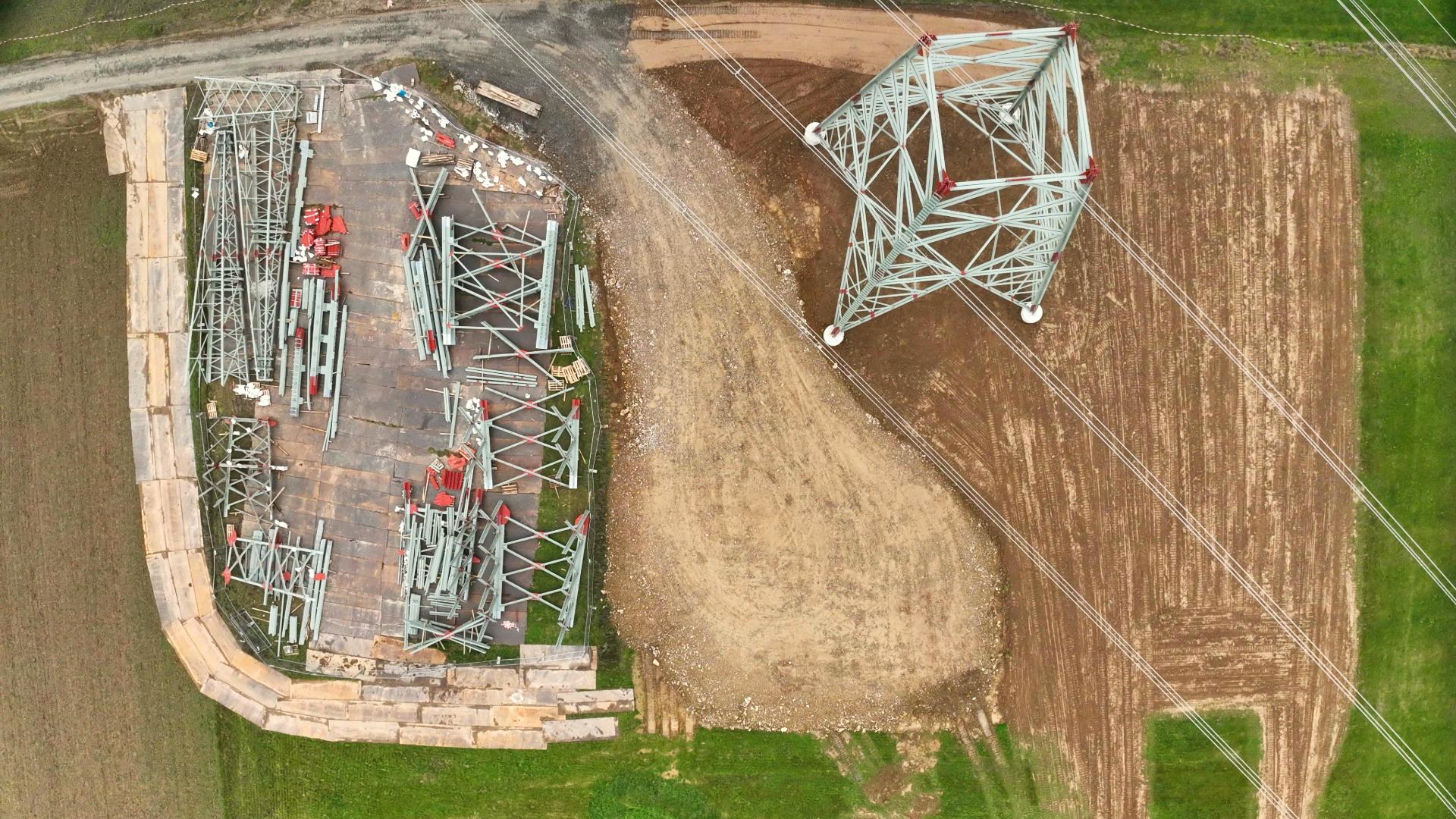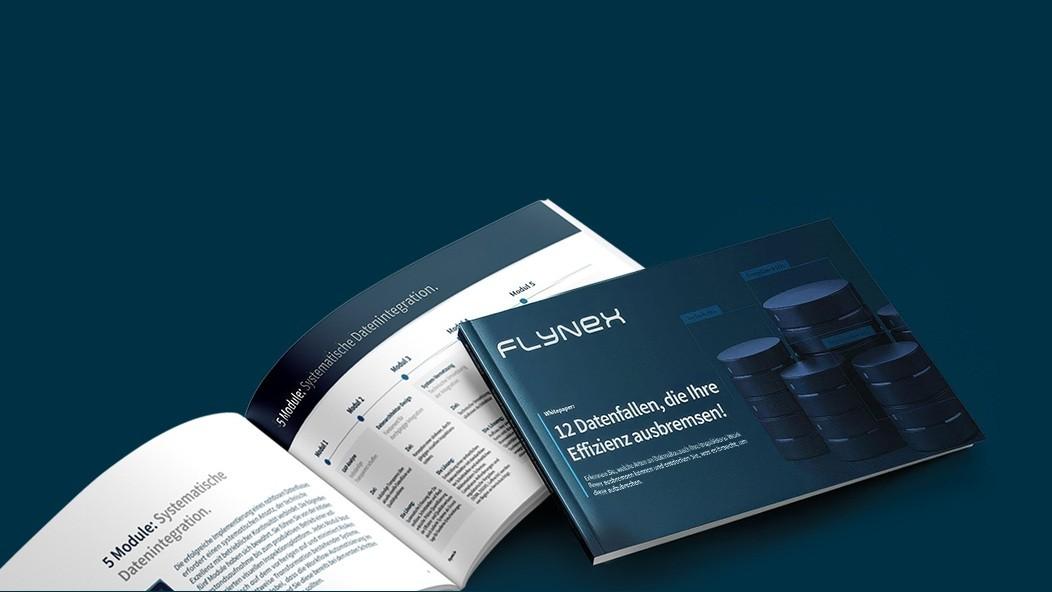Die neuen EU-Drohnenverordnung unterteilt Flüge in unterschiedliche Betriebskategorien. Das heißt, seit diesem Jahr wird zwischen Flügen in den Kategorien „offen“, „speziell“ und „zulassungspflichtig“ unterschieden. Die Kategorie „offen“ deckt dabei die Mehrheit der (privaten) Flüge ab, wofür Behörden unter Einhaltung aller Voraussetzungen keine gesonderte Erlaubnis verlangen.
Der kommerzielle Einsatz von UAS wächst jedoch stetig. Da diese Flüge in der Regel in die Kategorie „speziell“ fallen, handelt es sich bei gewerblichen Einsätzen also bis auf wenige Ausnahmen um erlaubnispflichtige Flüge. So wird für Flüge in dieser Kategorie eine Aufstiegsgenehmigung benötigt, die in Form einer Betriebserklärung, Betriebsgenehmigung oder eines Betreiberzeugnis beantragt werden kann. Im letzten Artikel haben wir uns bereits mit der Betriebserklärung befasst.
In diesem Artikel geht es um den Antrag auf Betriebsgenehmigung. Dafür muss ein Betriebskonzept erstellt und eine Risikobewertung des Vorhabens durchgeführt werden. Für die Risikobewertung gibt es mehrere Möglichkeiten, auf die wir im Folgenden eingehen werden.
Wie Sie vorgehen und was Sie für einen Antrag benötigen
Wer einen Flug in der „speziellen“ Kategorie plant, muss zunächst in Form eines Betriebskonzeptes (auch ConOps genannt) sein Vorhaben genau beschreiben. Im nächsten Schritt soll anhand einer Risikobewertung geprüft werden, welches Risiko das Betriebskonzept birgt. Um hier den Aufwand für Betreiber und Behörde zu verringern, sind vordefinierte Szenarien erstellt worden.
Die Standardszenarien (STS) sind die risikoärmsten Flugszenarien mit fest definierten Vorgaben, z. B. zur Flughöhe. Entspricht das Vorhaben eines der STS, so ist eine (ausführliche) Risikobewertung nicht notwendig. Daher sollte im ersten Schritt immer geprüft werden, ob eines der STS auf den Flug zutrifft. Ist das der Fall muss lediglich eine Betriebserklärung abgegeben werden, die das grobe Betriebskonzept mit den vorgeschriebenen Inhalten nach Anlage 5 der DVO 2020/639 beinhaltet.
Standardszenarien kommen allerdings erst ab dem 03.12.2023 zur Anwendung. Greift kein Standardszenario, wie es aktuell der Fall ist, muss ein Antrag auf Betriebsgenehmigung bei der zuständigen Landesluftfahrtbehörde gestellt und das ausgearbeitete Betriebskonzept inklusive Risikobewertung als PDRA (Pre-Defined Risk Assessment) oder SORA (Specific Operational Risk Assessment) eingereicht werden. Das PDRA stellt eine Erweiterung der STS mit etwas höherem Risiko dar. Daher bedarf es dafür nur einer verkürzten SORA-Risikobewertung.
DAS BETRIEBSKONZEPT (CONOPS)
Die Behörde genehmigt Drohnenflüge in der Kategorie „speziell“ grundsätzlich auf Basis eines Betriebskonzeptes (abgekürzt ConOps oder auch Betriebshandbuch genannt), welches einer ausführlichen Risikoanalyse unterzogen wird (dazu unten mehr). Nach Artikel 11 der neuen EU-Drohnenverordnung müssen für die Beantragung einer Genehmigung alle relevanten technischen und betrieblichen Informationen innerhalb eines ConOps bereitgestellt werden.
Das Concept of Operations ist eine Prozessbeschreibung, in der alle Details zum Flugvorhaben und zur Risikominderung beschrieben werden. Vom Team bis hin zur Ausstattung des UAS ist alles enthalten. Ein ausführliches Konzept erhöht die Chancen auf eine positive Betriebsgenehmigung entscheidend. Eine Genehmigung erteilt die für das Bundesland zuständige Luftfahrtbehörde (hier finden Sie eine Liste der Landesluftfahrtbehörden in Deutschland). Wichtig: Eine Betriebsgenehmigung wird immer in dem Bundesland beantragt, in dem die Person oder das Unternehmen sitzt.
Für die Betriebsgenehmigung muss eine Risikobewertung durchgeführt werden, dessen Ergebnisse wiederum den Inhalt des Betriebskonzeptes bestimmen können. Wenn bei der Risikobewertung demnach noch potenzielle Risiken ermittelt werden, auf die das Betriebskonzept bisher nicht eingegangen ist, muss das Konzept nachträglich angepasst werden.
Was beinhaltet ein ConOps?
Das Luftfahrt-Bundesamt (LBA) hat in Zusammenarbeit mit mehreren Landesluftfahrtbehörden eine ausführliche Vorlage für die Erstellung eines ConOps und einer Risikobewertung erstellt. Die Vorlage inkl. der Risikobewertung nach SORA gibt es hier.
Ein Auszug aus der Vorlage als Beispiel für den Aufbau und den Inhalt eines ConOps:
Eine vollständige und umfassende Liste aller möglichen Inhaltspunkte mit Erklärungen findet sich unter „Annex A to AMC1 to Article 11 (S. 57 ff.) des von der EASA veröffentlichten Easy Access Rules for Unmanned Aircraft Systems (Stand: Juni 2021).
DIE RISIKOBEWERTUNG
Wie bereits oben erläutert, muss das ConOps einer Risikoanalyse unterzogen werden. Damit kann das Risiko des Einsatzes klassifiziert und entsprechende Sicherheitsmaßnahmen festgelegt werden. Für die Risikobewertung gibt es drei Möglichkeiten. Mit zunehmendem Aufwand: STS, PDRA und SORA.
Die Standardszenarien (STS), die für eine Betriebserklärung benötigt werden, haben wir in diesem Artikel genauer erläutert. Sie sind vordefiniert und beschreiben ein eher geringes Risiko, weshalb eine einfache Erklärung des Betriebs nach einem STS gegenüber der Behörde genügt (erst ab dem 03.12.2023 möglich). Hier ist demnach keine eigene Risikoanalyse durchzuführen, da die Risikoparameter innerhalb der verschiedenen Szenarien schon festgelegt sind.
Eine Weiterführung der STS ist das PDRA (Pre-Defined Risk Assessment). Da es sich hierbei ebenfalls um vordefinierte Szenarien handelt, wird auch von den PDRAs (-Szenarien) gesprochen. Diese bergen im Vergleich zu den STS einen höheren Risikofaktor, was demnach beim Betrieb zu berücksichtigen ist. Aufgrund des höheren Risikos bedarf es hier auch eines umfangreicheren Betriebskonzeptes und einer Risikobewertung, bei der allerdings einige Schritte übersprungen werden können, da diese Parameter in den einzelnen PDRAs bereits festgelegt sind.
Wenn die Anforderungen an die PDRAs nicht erfüllt werden können, muss eine Risikobewertung nach SORA durchgeführt werden (dazu mehr unten).
Wichtige Hinweise
- Die STS beziehen sich ausschließlich auf C-klassifizierte Drohnen. Daher ist das Fliegen nach einem STS erst ab Dezember 2023 möglich.
- Die PDRAs können auch mit Bestandsdrohnen, also nicht C-klassifizierten Drohnen, geflogen werden und finden daher jetzt schon Anwendung.
- Die STS wurden in der EU-Drohnenverordnung festgelegt. Die PDRAs hingegen wurden von der EASA definiert, um den Aufwand einer vollständigen Risikobewertung zu verkürzen. Zukünftig könnte auch das Luftfahrt-Bundesamt weitere Szenarien definieren.
Die Standardszenarien (STS)
Die Standardszenarien (STS) sind die risikoärmsten vordefinierten Szenarien. Fällt das Flugvorhaben in eines dieser beschriebenen Kategorien, ist eine Betriebserklärung anzufertigen. Die Erklärung wird beim LBA eingereicht. Allerdings ist dies erst ab Dezember 2023 möglich. Eine Vorlage für die Betriebserklärung kann Anlage 2 der DVO 2020/639 entnommen werden.
Die STS sollen den Aufwand für die Behörden bei Genehmigungsverfahren senken und die meisten Anwendungsfälle abdecken. Für Deutschland sind momentan zwei STS (nach Anlage 1 der DVO 2020/639) definiert, die voraussichtlich ab dem 03.12.2023 gelten:
STS-01 für C5-Drohnen
- VLOS
- Kontrollierter Bodenbereich (Flugzone, Notfallzone, Pufferzone)
- Fernpilotenzeugnis benötigt + praktisches Training für STS1
- Luftraum: Kontrolliert oder unkontrolliert mit geringem Risiko der Begegnung mit einem bemannten Luftfahrzeug
- Maximale Flughöhe: 120 m
- Maximale Geschwindigkeit: 5 m/s
STS-02 für C6-Drohnen
- BVLOS (max. 1 km horizontale Entfernung)
- EVLOS (max. 2 km horizontale Entfernung)
- Fernpilotenzeugnis benötigt + praktisches Training für STS1 + STS2
- Luftraum: Kontrolliert oder unkontrolliert mit geringem Risiko der Begegnung mit einem bemannten Luftfahrzeug
- Maximale Flughöhe: 120 m
- Maximale Geschwindigkeit: 50 m/s
Pre-Defined Risk Assessment (PDRA)
Das Pre-Defined Risk Assessment (verkürzte Risikoanalyse) beinhaltet einige Risikoparameter, die bereits vordefiniert sind und in verschiedenen Szenarien (z. B. PDRA-01) dargestellt werden. Daher wird wie bei den STS auch von den PDRAs (-Szenarien) gesprochen.
Sie beschreiben riskantere Flüge, weshalb eine einfache Betriebserklärung nicht ausreicht. Grundsätzlich dienen sie dazu, den SORA-Prozess zu verkürzen. Stellt sich nach der Erstellung des Betriebskonzeptes heraus, dass das Vorhaben in ein PDRA fällt, können einige Schritte der SORA übersprungen werden.
Die verschiedenen PDRAs enthalten in ihrer Definition schon die entsprechenden Werte für die finale GRC (Ground Risk Class; Bodenrisikoklasse), die finale ARC (Air Risk Class; Luftrisikoklasse) und für SAIL (Specific Assurance and Integrity Level). Diese werden zur Ermittlung der OSO (Operational Safety Objectives) herangezogen (siehe Abschnitt SORA).
Unten finden Sie alle bis jetzt definierten PDRAs mit den dazugehörigen Abschnitten der Easy Access Rules for Unmanned Aircraft Systems (z. B. AMC2) der EASA, in der alle Kriterien nochmal ausführlich beschrieben sind.
Hier besteht u. a. ein Bezug zu den Standardszenarien: PDRA-S01 ist vergleichbar mit STS-01 und PDRA-S02 ist vergleichbar mit STS-02. Wesentlicher Unterschied ist, dass das UAS eine Bestandsdrohne oder ein Eigenbau sein kann, was bei den STS nicht der Fall ist. Voraussetzung für die Anwendung von Standardszenarien ist u. a. der Betrieb einer C-klassifizierten Drohne. Das „G“ bei den PDRA-G steht für „Generic“ und stellt weitere, allgemein auftretende Missionen dar.
PDRA-S01
- UAS mit max. 3 m Durchmesser und Startgewicht bis zu 25 kg
- VLOS
- Überflug von kontrolliertem Bodenbereich, der sich in einem bewohnten Gebiet befinden kann
- Maximale Flughöhe: 120 m
- Luftraum: Kontrolliert oder unkontrolliert mit geringem Risiko der Begegnung mit einem bemannten Luftfahrzeug
- AMC4 Article 11
PDRA-S02
- UAS mit max. 3 m Durchmesser und Startgewicht bis zu 25 kg
- BVLOS (max. 1 km horizontale Entfernung)
- EVLOS (Extended Visual Line of Sight, max. 2 km horizontale Entfernung)
- Überflug von kontrolliertem Bodenbereich, der sich vollständig in einem dünn besiedelten Gebiet befindet
- Maximale Flughöhe: 120 m
- Luftraum: Kontrolliert oder unkontrolliert mit geringem Risiko der Begegnung mit einem bemannten Luftfahrzeug
- AMC5 Article 11
PDRA-G01
- UAS mit max. 3 m Durchmesser und typische kinetische Energie bis zu 34 kJ
- BVLOS (max. 1 km Entfernung)
- EVLOS (keine Begrenzung, aber max. 1 km Entfernung zwischen Beobachtern)
- Überflug von dünn besiedeltem Gebiet
- Maximale Flughöhe: 150 m (Operational Volume)
- Luftraum: Unkontrolliert mit geringem Risiko der Begegnung mit einem bemannten Luftfahrzeug
- AMC2 Article 11
PDRA-G02
- UAS mit max. 3 m Durchmesser und typische kinetische Energie bis zu 34 kJ
- BVLOS
- Überflug von dünn besiedeltem Gebiet
- Maximale Flughöhe: abhängig vom Flugvorhaben
- In einem Luftraum, der für den Betrieb reserviert ist
- AMC3 Article 11
Specific Operational Risk Assessment (SORA)
Der EASA-SORA Prozess ist im Artikel 11 der DVO 2019/947 beschrieben und als geeignetes, europaweit anerkanntes Mittel zur Risikobewertung genannt. Entsprechend ist das ehemalige nationale SORA-GER nicht mehr gültig.
Rechts finden Sie den gesamten Prozess einer SORA abgebildet. Unten werden die einzelnen Schritte nochmal im Detail erläutert.
Wichtig: Das Thema Robustheit zieht sich durch das gesamte SORA-Konzept und ist deshalb wichtig für das Verständnis. Damit ist gemeint, dass jedes Risikominderungs- oder Betriebssicherheitsziel auf verschiedenen Ebenen der Robustheit nachgewiesen werden kann. Der SORA-Prozess schlägt drei verschiedene Stufen der Robustheit vor: niedrig, mittel und hoch. Die Einstufung der Robustheit erfolgt sowohl über den Grad der Integrität (den Sicherheitsgewinn) als auch über den Grad der Gewissheit darüber, dass der behauptete Sicherheitsgewinn erreicht wurde. Ein hohe Robustheit ist demnach anzustreben.
Das aufwendige Verfahren einer Genehmigung sollte Sie nicht von Ihrem Vorhaben abschrecken. Ist das Dokument einmal erstellt, muss es nur bei grundlegenden Änderungen aktualisiert werden. Eine Genehmigung kann so für wiederholende Flüge ausgehändigt werden.
Benötigen Sie Hilfe beim Beantragen einer Betriebsgenehmigung? Wir stehen Ihnen gerne zur Seite und übernehmen die Arbeit für Sie. Hier geht es zu unserem Genehmigungsservice.
Wir wünschen sichere Flüge,
Ihr FlyNex Team











